第1讲 专业英语概述
- 格式:ppt
- 大小:304.50 KB
- 文档页数:19
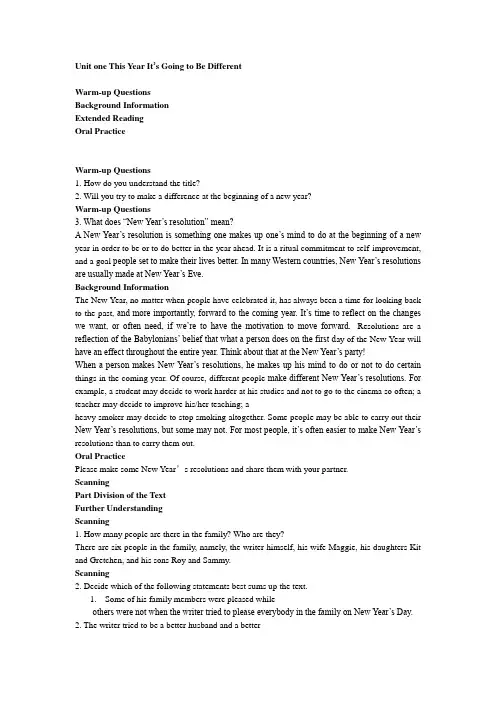
Unit one This Year It’s Going to Be DifferentWarm-up QuestionsBackground InformationExtended ReadingOral PracticeWarm-up Questions1. How do you understand the title?2. Will you try to make a difference at the beginning of a new year?Warm-up Questions3. What does “New Year’s resolution” mean?A New Year’s resolution is something one makes up one’s mind to do at the beginning of a new year in order to be or to do better in the year ahead. It is a ritual commitment to self-improvement, and a goal people set to make their lives better. In many Western countries, New Year’s resolutions are usually made at New Year’s Eve.Background InformationThe New Year, no matter when people have celebrated it, has always been a time for looking back to the past, and more importantly, forward to the coming year. It’s time to reflect on the changes we want, or often need, if we’re to have the motivation to move forward.Resolutions are a reflection of the Babylonians’ belief that what a person does on the first d ay of the New Year will have an effect throughout the entire year. Think about that at the New Year’s party!When a person makes New Year’s resolutions, he makes up his mind to do or not to do certain things in the coming year. Of course, different people make different New Year’s resolutions. For example, a student may decide to work harder at his studies and not to go to the cinema so often; a teacher may decide to improve his/her teaching; aheavy smoker may decide to stop smoking altogether. Some people may be able to carry out their New Year’s resolutions, but some may not. For most people, it’s often easier to make New Year’s resolutions than to carry them out.Oral PracticePlease make some New Year’s resolutions and share them with your partner.ScanningPart Division of the TextFurther UnderstandingScanning1. How many people are there in the family? Who are they?There are six people in the family, namely, the writer himself, his wife Maggie, his daughters Kit and Gretchen, and his sons Roy and Sammy.Scanning2. Decide which of the following statements best sums up the text.1.Some of his family members were pleased whileothers were not when the writer tried to please everybody in the family on New Year’s Day. 2. The writer tried to be a better husband and a betterfather in the new year, and his family membersappreciated this.3. The writer carried out his New Year’s resolutionsfaithfully to improve himself, but the results allwent contrary to his expectations.Part Division of the TextDirections: The text has been divided into several parts.Please summarize the main idea of each part.Part 1 (Para.1)The writer wanted to improve himself by carrying out his New Year’s resolutions.Part 2 (Para.2—Para.4)His resolutions did not work well with his wife.Part 3 (Para.5—Para.8)His resolutions did not work well with the boys.Part 4 (Para.9—Para.14)His resolutions did not work well with the girls.Part 5 (Para.15—Para.16)The carrying out of his resolutions led to a chaos among the children.Part 6 (Para.17—Para.20)The carrying out of his resolutions further offended his wife.Part 7 (Para.21—Para.24)The harder he tried, the more irritated his family members were.Part 8 (Para.25—Para.32)The writer made a confession.Part 9 (Para.33—Para.37)The writer became his old self and everything was back to normal.Detailed ReadingNew Year’s resolutions are like anything else—you get out of them what you put in.What does this sentence mean?A s the saying goes, “As you sow, so will you reap”, which means whatever a man sows he will reap. The writer intends to convince the reader that making New Year’s resolutions also follows this maxim. The more resolutions you make at the beginning of the year, the better results you will have.Pretty clearly, anyone who followed my collection of rules would be blessed with a richer life, boundless love from his family, and the admiration of the community.Paraphrase this sentence.Quite obviously, anyone who was determined to be guided by the rules of self-improvement I collected would be happy and have an eventful life, infinite affection from his family and the respect of the community.Be spontaneous in showing affection.Show your love readily and willingly.“Don’t ever sneak up on me like that again!”Never creep up on me like that again!Why did Maggie react to her husband’s kiss in this way?Probably the husband seldom did this kind of romantic thing (steal a kiss from behind) before.A sincere compliment is worth its weight in gold.Whole-hearted and genuine praise is very valuable.“It wasn’t my idea to stay out until four a.m.”I didn’t want to remain outside until four in the morning! It was your idea!Was Maggie pleased to hear the “sincere compliment”?Why or why not?Maggie was very much annoyed by the “sincere compliment”, because she didn’t look “lovely” at all due to lack of sleep. Therefore, she thought her husband was speaking sarcastically.Roy sure is smart.“Sure” is often used in colloquial American English, meaning “certainly”. “Roy sure is smart” means “Roy certainly is clever.” By making such a remark, Sammy actually suggested that his father was not so bright.Meet your child at his own level.Join your children and treat them as your equals. / Speak, act and think as your children do.It isn’t either happy.The normal order of the sentence is: “It isn’t happy, either.” The word “either” in the sentence shows emphasis. The sentence is an example of child talk, meaning “It isn’t happy at all!” or “It’s very unhappy.”I’ll bet the fellows are swarming around.The sentence means “I’m sure many young men are after you.”Do you think it is appropriate for the writer to saysomething about “the fellows swarming around” toMarilyn?No, it is inappropriate. And that’s why Marilyn thought she was cross-examined by the writer. There was a series of shrieks down the hall. I found Gretchen in tears.I heard screams down the hall one after another and I found Gretchen crying.I suggested that they carve something for their mother—like a salad spoon.The sentence means “I suggested that they should carve something for their mother, for example, a salad spoon, by using the scout knife.”The most trivial chore can prove rewarding if approached with zest.The most unimportant light task may turn out to be worthwhile if it is dealt with eagerly and enthusiastically.I struck up a conversation with Kit, trying to establish some kind of rapport.I started to have a conversation with Kit in a friendly way and tried my best to achieve agreement and understanding between us.Anybody else would have thrown in the sponge…What does “throw in the sponge” mean?The idiom “throw in the sponge/towel” comes from boxing. It means “to admit that you have been defeated”.Anybody else would have admitted defeat and given up.…they had the nerve to say you suggested it.What does this sentence mean?The sentence means “they were rude enough to say that you suggested that they carve my saladspoon”.Kit has been in a poisonous mood.What is the meaning of this sentence?It means that “Kit has been in a very bad temper”.You never bothered with small talk before. Why start now?Paraphrase this sentence.You never troubled yourself to chat with people in the past. Why do you want to start doing it now?If the kids do something and you get mad, they know where they stand.What is the meaning of this sentence?It means “If the children do something and you become angry, they know they are wrong”.And when I tell you to do something, jump!What is the meaning of this sentence?It means “When I tell you to do something, hurry up and do it”.Words &Phrasesresolution: n.decision or mental pledge to do or not to do somethingShe’s always making good resolutions b ut she never carries them out.He lacked the resolution to get through medical school.Courage and resolution are the spirit and soul of virtue. 勇敢和决心是美德的灵魂。
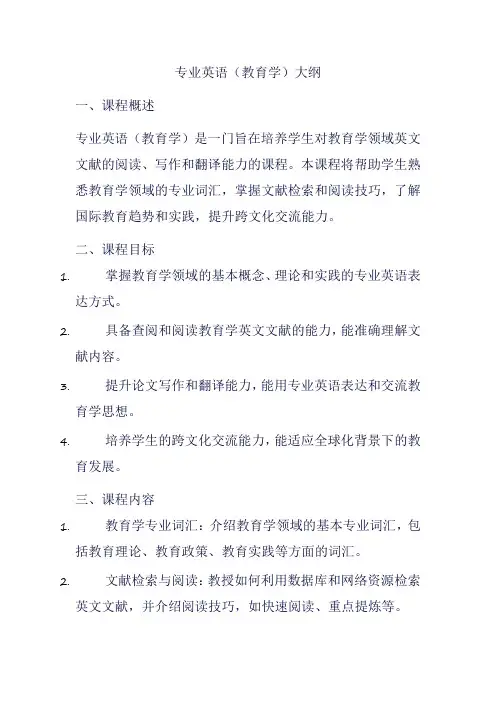
专业英语(教育学)大纲一、课程概述专业英语(教育学)是一门旨在培养学生对教育学领域英文文献的阅读、写作和翻译能力的课程。
本课程将帮助学生熟悉教育学领域的专业词汇,掌握文献检索和阅读技巧,了解国际教育趋势和实践,提升跨文化交流能力。
二、课程目标1.掌握教育学领域的基本概念、理论和实践的专业英语表达方式。
2.具备查阅和阅读教育学英文文献的能力,能准确理解文献内容。
3.提升论文写作和翻译能力,能用专业英语表达和交流教育学思想。
4.培养学生的跨文化交流能力,能适应全球化背景下的教育发展。
三、课程内容1.教育学专业词汇:介绍教育学领域的基本专业词汇,包括教育理论、教育政策、教育实践等方面的词汇。
2.文献检索与阅读:教授如何利用数据库和网络资源检索英文文献,并介绍阅读技巧,如快速阅读、重点提炼等。
3.论文写作与翻译:讲解如何撰写和翻译教育学领域的英文论文,包括论文结构、语言表达、语法和时态等方面的内容。
4.跨文化交流能力培养:通过案例分析、角色扮演等方式,培养学生的跨文化交流能力,包括沟通技巧、礼仪文化等。
5.教育学发展趋势与国际比较:介绍全球教育发展趋势和国际教育政策比较,帮助学生了解不同国家的教育制度和政策。
四、课程评价1.课堂参与度:鼓励学生积极参与课堂讨论,提问和回答问题,以及参与小组活动。
2.平时作业:布置相关阅读材料、翻译和写作作业,加强学生对课堂知识的理解和应用。
3.期末考试:通过笔试和口试相结合的方式,测试学生对课程内容的掌握程度和实际应用能力。
五、教师角色与职责1.提供清晰的学习目标和要求,确保学生了解课程内容和评价方式。
2.定期检查学生的学习进度和理解程度,及时给予反馈和建议。
3.提供学习资源和支持,包括推荐相关书籍、文章、网站等资源,为学生提供学术和情感支持。
4.鼓励学生的独立思考和创新精神,培养他们在教育学领域的知识和能力。
5.与学生保持积极沟通,解决学生在学习和生活中的问题,创造良好的学习环境。

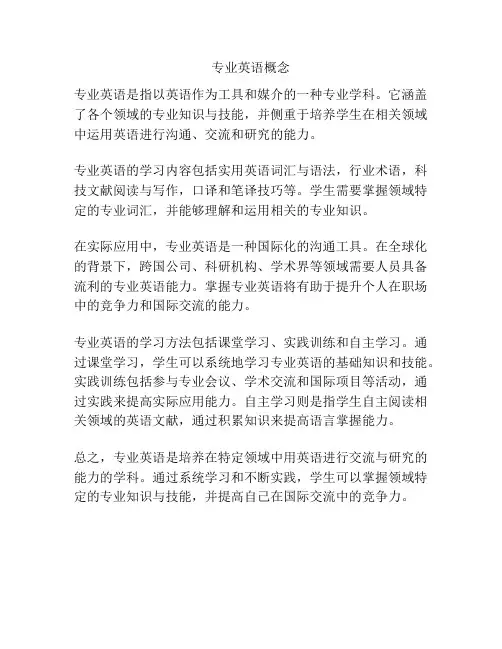
专业英语概念
专业英语是指以英语作为工具和媒介的一种专业学科。
它涵盖了各个领域的专业知识与技能,并侧重于培养学生在相关领域中运用英语进行沟通、交流和研究的能力。
专业英语的学习内容包括实用英语词汇与语法,行业术语,科技文献阅读与写作,口译和笔译技巧等。
学生需要掌握领域特定的专业词汇,并能够理解和运用相关的专业知识。
在实际应用中,专业英语是一种国际化的沟通工具。
在全球化的背景下,跨国公司、科研机构、学术界等领域需要人员具备流利的专业英语能力。
掌握专业英语将有助于提升个人在职场中的竞争力和国际交流的能力。
专业英语的学习方法包括课堂学习、实践训练和自主学习。
通过课堂学习,学生可以系统地学习专业英语的基础知识和技能。
实践训练包括参与专业会议、学术交流和国际项目等活动,通过实践来提高实际应用能力。
自主学习则是指学生自主阅读相关领域的英语文献,通过积累知识来提高语言掌握能力。
总之,专业英语是培养在特定领域中用英语进行交流与研究的能力的学科。
通过系统学习和不断实践,学生可以掌握领域特定的专业知识与技能,并提高自己在国际交流中的竞争力。
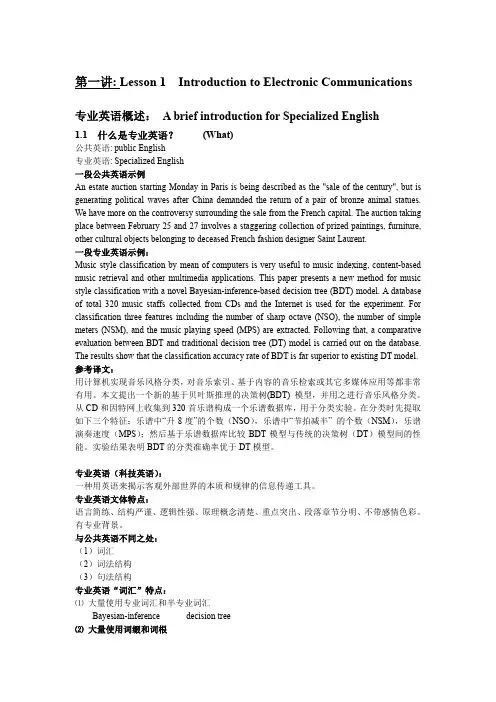
第一讲: Lesson 1 Introduction to Electronic Communications专业英语概述: A brief introduction for Specialized English1.1 什么是专业英语? (What)公共英语: public English专业英语: Specialized English一段公共英语示例An estate auction starting Monday in Paris is being described as the "sale of the century", but is generating political waves after China demanded the return of a pair of bronze animal statues. We have more on the controversy surrounding the sale from the French capital. The auction taking place between February 25 and 27 involves a staggering collection of prized paintings, furniture, other cultural objects belonging to deceased French fashion designer Saint Laurent.一段专业英语示例:Music style classification by mean of computers is very useful to music indexing, content-based music retrieval and other multimedia applications. This paper presents a new method for music style classification with a novel Bayesian-inference-based decision tree (BDT) model. A database of total 320 music staffs collected from CDs and the Internet is used for the experiment. For classification three features including the number of sharp octave (NSO), the number of simple meters (NSM), and the music playing speed (MPS) are extracted. Following that, a comparative evaluation between BDT and traditional decision tree (DT) model is carried out on the database. The results show that the classification accuracy rate of BDT is far superior to existing DT model. 参考译文:用计算机实现音乐风格分类,对音乐索引、基于内容的音乐检索或其它多媒体应用等都非常有用。
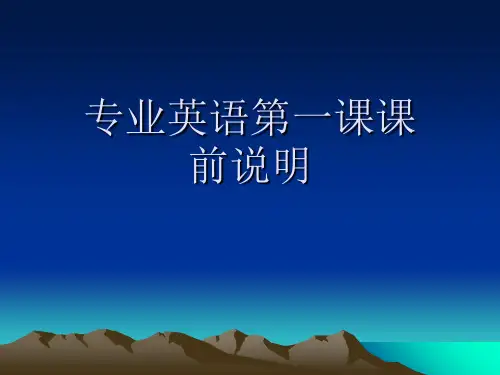

专业英语基本介绍
专业英语,是指用英语进行与某个行业或领域相关的沟通、交流或表达。
它主要是为了交流和传递特定领域的专业知识和信息,是一种特殊的语言能力。
因此,对于那些希望在特定领域获得成功的人来说,掌握专业英语是非常重要的。
掌握专业英语需要学习专业的词汇和术语、语法结构和语用规则。
这需要学习者具备一定的语言基础和特定的领域知识。
对于想要掌握专业英语的人来说,首先需要了解自己所学领域的专业术语和名词。
这样可以更好地理解文本,并更容易将其应用到实际工作中。
在英语专业中,有一定的语法结构和语用规则,也需要学习者进行掌握。
比如,不同领域或行业使用的语言风格和用词方式可能不同,因此掌握语用规则非常必要,不仅可以避免使用不当的用语,还可以更好地达到交际目的。
专业英语主要应用于国际贸易、法律、医学、信息科技、金融等领域,它在国际上的影响和重要性日益增强。
在翻译、商务谈判、跨文化交流等方面都非常重要。
通过专业英语,人们可以更好地理解和掌握不同领域的知识和技能,从而更好地实践和应用这些知识和技能。
所以,在当前高度开放和全球化的背景下,掌握专业英语非常有必要。
掌握专业英语需要多种方法,例如在语言环境中学习、参加英语培训、阅读相关文献、与外籍专家交流等方法。
通过这些方法,可以更好地掌握专业英语,提高语言能力和跨文化交流能力。
总之,掌握专业英语是一种必要的语言能力,它在国际化的背景下越来越重要。
为了更好地应对国际竞争和挑战,人们需要努力加强自己的专业英语能力,不断学习和实践。
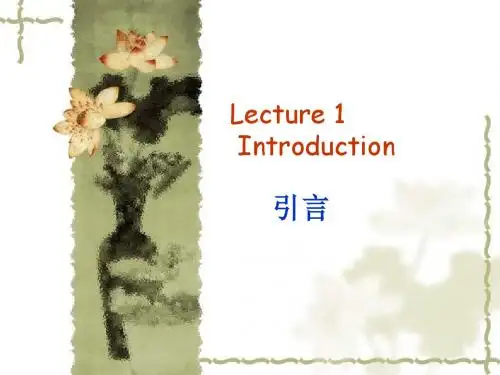

机械工程专业英语第一课机械工程专业英语概述English in Mechanical Engineering一、专业英语概述1. 什么是翻译:翻译就是将一种语言文字的意义用另一种语言文字表达出来。
机械工程英语翻译就是将机械工程学科的英语原著由原作语言(source language)用译文语言(target language)忠实、准确、严谨、通顺、完整地再现出来,使人们能够借助汉语译文准确无误地了解英语机械工程著作所阐述的工程技术内容和科学理论。
机械工程专业英语概述English in Mechanical Engineering2. 翻译例句例1. Control Center, Smoking Free.例2. The tolerance should not be so big.例3. A dog driver stop the rotation of the wheel. 例4. Connect the black pigtail with thedog-house.例5. The importance of computer in the use of manufacturing can not be overestimated.机械工程专业英语概述English in Mechanical Engineering例1. Control Center, Smoking Free.错误译法:控制中心,吸烟自由。
正确译法:控制中心,严禁吸烟。
例2. The tolerance should not be so big.a. 此公差不应给这么大。
(机械学)b. 忍耐力不会有这么大。
(关于人体的耐受性)c. 抗毒性不会有这么强。
(医学)例3. A dog driver stop the rotation of the wheel. 错误译法:狗驾驶员使轮子停转。
专业译法:止动器使轮子停止旋转。
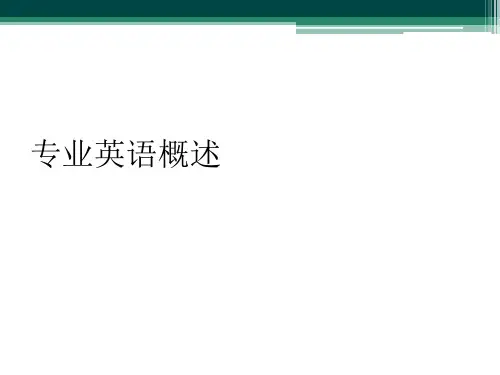
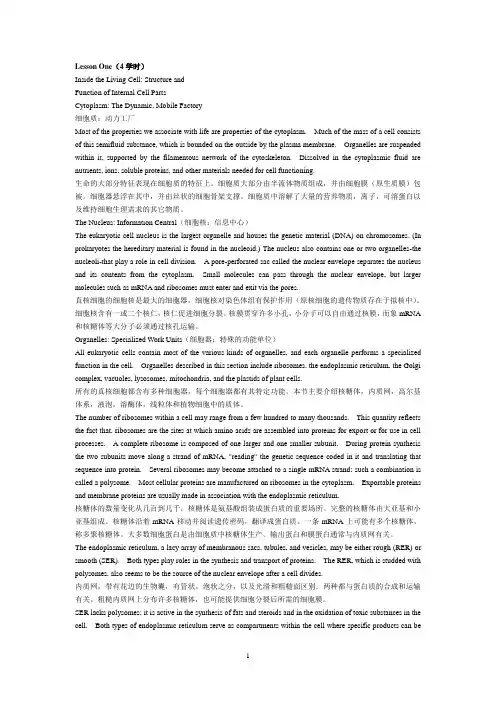
Lesson One(4学时)Inside the Living Cell: Structure andFunction of Internal Cell PartsCytoplasm: The Dynamic, Mobile Factory细胞质:动力工厂Most of the properties we associate with life are properties of the cytoplasm. Much of the mass of a cell consists of this semifluid substance, which is bounded on the outside by the plasma membrane. Organelles are suspended within it, supported by the filamentous network of the cytoskeleton. Dissolved in the cytoplasmic fluid are nutrients, ions, soluble proteins, and other materials needed for cell functioning.生命的大部分特征表现在细胞质的特征上。
细胞质大部分由半流体物质组成,并由细胞膜(原生质膜)包被。
细胞器悬浮在其中,并由丝状的细胞骨架支撑。
细胞质中溶解了大量的营养物质,离子,可溶蛋白以及维持细胞生理需求的其它物质。
The Nucleus: Information Central(细胞核:信息中心)The eukaryotic cell nucleus is the largest organelle and houses the genetic material (DNA) on chromosomes. (In prokaryotes the hereditary material is found in the nucleoid.) The nucleus also contains one or two organelles-the nucleoli-that play a role in cell division. A pore-perforated sac called the nuclear envelope separates the nucleus and its contents from the cytoplasm. Small molecules can pass through the nuclear envelope, but larger molecules such as mRNA and ribosomes must enter and exit via the pores.真核细胞的细胞核是最大的细胞器,细胞核对染色体组有保护作用(原核细胞的遗传物质存在于拟核中)。
第一课专业英语基础一、专业英语概论专业英语的英文原文:English for Special Purpose专业英语教学的特点:语言密切结合专业知识教材来源:相关的专业文献,如理工科的专业文献有文摘、论文、专著、教科书、研究报告、专利说明书、标准、产品样本和说明书等其中,论文、专著和教科书的语言风格相近,又是科技人员的主要阅读对象,应该作为专业阅读课的主要内容。
阅读文摘是是阅读其它文献的前奏。
专利文献一方面要阐述技术问题,另一方面它涉及到权益,因此具有法律文体的特点,在语言上比较难,也是需要学习的内容。
专业文献查阅手段:传统方法和因特网科技人员阅读专业英语文献的目的:理解和掌握文献所述的理论和方法,以便在科研或生产实践中实施这些理论方法,或进一步发展改进这些理论方法。
科技文献写作的特点:严谨、简洁专业英语阅读要点:理解二、专业英语的基本特点在文章结构方面:逻辑严谨,层次分明在用词方面:大量专业词汇和专业术语在语法方面:非人称的语气和客观的态度,较多地使用被动语态,并采用图表等非语言因素的表达手段第二课因特网的信息检索一.因特网的信息资源1、World Wide Web信息资源2、Telnet信息资源3、FTP信息资源4、Usenet用户服务组信息资源5、Gopher信息资源二.因特网信息检索1、因特网检索工具2、因特网图书与期刊信息检索1)图书馆公共可检索目录(OPAC)2)电子期刊3)机械工程专业信息检索ASME (American Society of Mechanical Engineers),SAE ( Society of Automobile Engineers ) ,IMECHE (Institution of Mechanical engineers )第三课文献检索按出版类型划分,专业文献可分为图书、期刊和特种文献三大类。
一、期刊和会议文献的检索1、Engineering Index, Ei美国工程索引是最具有影响力的工程技术文摘性期刊,报道的内容遍及工程技术的各个领域,Ei从五千多种国际性期刊和会议文集中收录文献和文摘,并且它所报道的文摘都是经过专家们精心挑选编撰的,具有很高的学术价值,深受广大工程技术人员的欢迎。
Lesson 1 Food IndusturyThe food industry is the complex, global collective of diverse businesses that together supply much of the food energy consumed by the world population. Only subsistence farmers, those who survive on what they grow, can be considered outside of the scope of the modern food industry.1.1ProductionFood is traditionally obtained through farming, ranching and fishing with hunting, foraging and other methods of subsistence locally important. More recently, there has been a growing trend towards more sustainable agricultural practices. This approach, which is partly fueled by consumer demand, encourages biodiversity, local self-reliance and organic farming methods.Major influences on food production are international organizations (e.g. the World Trade Organization and Common Agricultural Policy),national government policy (or law) and war.1.2PreparationWhile some food can be eaten raw, many foods undergo some form of preparation for reasons of safety, palatability, or flavor. At the simplest level this may involve washing, cutting, heating or cooling, pressure cooking, fermentation, or combination with other food. In a home, most food preparation takes place in a kitchen. Some preparation isdone to enhance the taste or aesthetic appeal; other preparation may help to preserve the food; and others may be involved in cultural identity. A meal is made up of food which is prepared to be eaten at a specific time and place.1.3Food processingFood processing is the methods and techniques used to transform raw ingredients into food for human consumption. Food processing takes clean, harvested or slaughtered and butchered components and used them to produce marketable food products. There are several different ways in which food can be produced.All food processing involves a combination of procedures to achieve the intended changes to the raw materials. There are conveniently categorized as unit operation, each of which has a specific, identifiable and predictable effect on a food. Unit operations are grouped together to form a process. The combination and sequence of operations determines the nature of the final product.1.4Food manufacturePackaged food are manufactured outside the home for purchase. This can be as simple as a butcher preparing meat, or as complex as a modern international food industry. Early food processing techniques were limited by available food preservation, packaging and transportation. This mainly involved salting, curing, curdling, drying,pickling, fermentation and smoking. Food manufacturing arose during the industrial revolution in the 19th century. This development took advantage of new mass markets and emerging new technology, such as milling,preservation, packaging and labeling and transportation. It brought the advantages of pro-prepared time saving food to the bulk of ordinary people who did not employ domestic servants.At the start of the 21 st century, a two-tier structure has arisen, with a few international food processing giants controlling a wide range of well-known food brands. There also exists a wide array of small local or national food processing companies. Advanced technologies have also come to change food manufacture. Computer-based control systems, sophisticated processing and packaging methods, and logistics and distribution advances, can enhance product quality, improve food safety, and reduce costs.1.5Marketing and retailingFood marketing brings together the producer and the consumer. It is the chain of activities that brings food from “farm gate to plate”.[1] The marketing of even a single food product can be a complicated process involving many producers and companies. For example, fifty-six companies are involved in making one can of chicken noodle soup.[2] These businesses include not only chicken and vegetable processors but also the companies that transport the ingredients and those who printlabels and manufacture cans. The food marketing system is the largest direct and indirect non-government employer in the United States.In the pre-modern era, the sale of surplus food took place once a week when farmers took their wares on market day, into the local village marketplace. Here food was sold to grocers for sale in their local shops for purchase by local consumers.[3]With the onset of industrialization, and the development of the food processing industry, a wider range of food could be sold and distributed in distant locations. Typically early grocery shops would be counter-based shops, in which purchasers told the shop-keeper what they wanted, so that the shop-keeper could get it for them.In the 20th century supermarkets were born. Supermarkets brought with them a self service approach to shopping using shopping carts, and were able to offer quality food at lower cost through economies of scale and reduced staffing cost. In the latter part of the 20th century, this has been further revolutionized by the development of vast warehouse-sized, out-of-town supermarkets, selling a wide range of food from around the world.Unlike food processors, food retailing is a two-tier market in which a small number of very large companies control a large proportion of supermarkets. The supermarket giants wield great purchasing power over farmers and processors, and strong influence over consumers.Nevertheless, less than ten percent of consumer spending on food goes to farmers, with larger percentages going to advertising, transportation, and intermediate corporations.[4]1.6Wholesale and distributionA vast global transportation network is required by the food industry in order to connect its numerous parts. These include suppliers, manufacturers, warehousing, retailers and the end consumers. There are also those companies that, during the food processing process, add vitamins, minerals, and other necessary requirements usually lost during preparation. Wholesale markets for fresh food products have tended to decline in importance in OECD countries as well as in Latin America and some Asian countries as a result of the growth of supermarkets, which procure directly from farmers or through preferred suppliers, rather than going through markets.[5]The constant and uninterrupted flow of product from distribution centers to store locations is a critical link in food industry operations. Distribution centers run more efficiently, throughput can be increased, costs can be lowered, and manpower better utilized if the proper steps are taken when setting up a material handling system in a warehouse.1.7Food industry technologiesSophisticated technologies define modern food production. They include many areas. Agricultural machinery, originally led by the tractor,has practically eliminated human labor in many areas of production. Biotechnology is driving much change, in areas as diverse as agrochemicals, plant breeding and food processing. Many other areas of technology are also involved, to the point where it is hard to find an area that does not have a direct impact on the food industry. Computer technology is also a central force, with computer networks and specialized software providing the support infrastructure to allow global movement of the myriad components involved.[6]Notes[1] It is the chain of activities that brings food from “farm gate to plate”.本句的主语It 指的是上面中的food marketing, 翻译时也可以用汉语代词“这”表示。